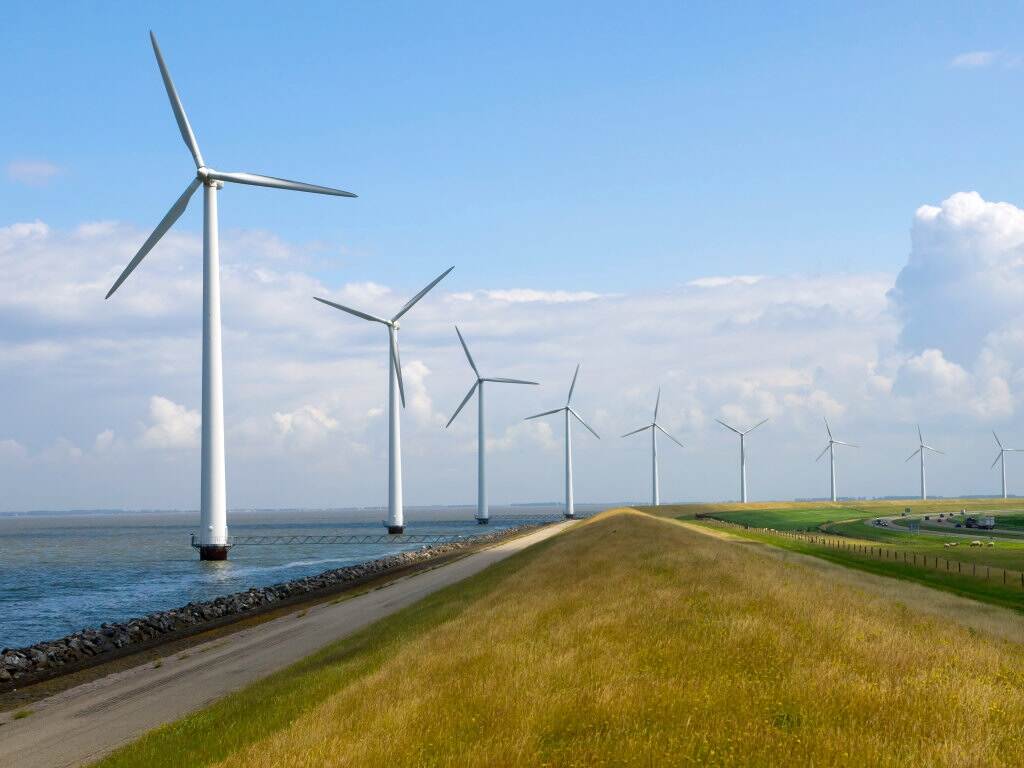New wind turbines will be added in all sorts of places in the Netherlands in the near future. The national government sees this form of clean energy as an important solution on the road to renewable energy. Wind turbines also have disadvantages. For example, there is a clear correlation between the noise level produced by wind turbines and the perceived amount of disruption. RIVM noise researcher Elise van Kempen outlines the current research on this topic. Oscar Breugelmans, policy advisor for the Public Health Service of Amsterdam, addresses the societal debate.
'Noise is a stressor'
'Local residents view health as an increasingly important priority'
“We are investigating the whole sound spectrum of the wind turbines, which ranges from normal sound to low-frequency sound and infrasonic frequencies. Infrasound is not usually within the range of human hearing,” says Elise van Kempen, noise researcher at RIVM. A review of scientific studies confirms an established link between noise levels produced by wind turbines and the perceived amount of disruption. What does this mean in tangible terms?
“Excessive noise is considered a harmful health effect in its own right,” Van Kempen explains. “This is in line with the World Health Organisation’s definition of health. But annoyance is also related to other health effects. Wind turbines produce less noise – in terms of decibels – than cars or planes. However, research shows that noise from wind turbines is considered excessive even at much lower decibel levels. For that reason, the noise standard for wind turbines is lower than for other noise sources.”
Insufficient evidence of other health effects
Insufficient evidence has been found to indicate a correlation between noise from wind turbines and sleep disturbance. Similarly, the studies did not find sufficient evidence of other health effects, such as cardiovascular disease, metabolic disorders, mental health and cognitive effects. Elise van Kempen: “That may mean that there is no relationship, or that not enough research has been done. Or sometimes the research may be poor quality, or yield contradictory results. We cannot reach firm conclusions yet.”
Elise van Kempen does know the effects that noise in general can cause. “Noise is a stressor. Noise stress causes your autonomic nervous system to put your body into an increased state of readiness, which leads to all kinds of physical responses. Negative perceptions of noise can also lead to stress, causing acute physical and psychological effects, such as high blood pressure.” Stress reduction can be achieved if people see opportunities to reduce noise levels themselves, even if only by closing a window.
Energy transition to renewable energy sources
The Netherlands is looking for ways to generate renewable energy. The traditional energy sources of coal, oil and natural gas are being replaced by renewable energy sources, such as wind power. This is referred to as the energy transition: an important part of the climate agreement.
The energy transition is vitally necessary and brings various advantages, but there are also health challenges involved in this theme. Noise from wind turbines is one such challenge. By providing knowledge, RIVM contributes to reducing or resolving these challenges.
Questions about the health effects of wind turbines are pouring in, as Van Kempen has observed – not only at RIVM, but also at the Municipal Public Health Services (GGDs). Elise van Kempen: “When it comes to these types of questions about environmental health, public authorities at the provincial and municipal levels should ideally contact their Municipal Public Health Services (GGDs). The local GGD is more familiar with the specific situation in that area. RIVM supports the GGDs in the form of knowledge and advice.”
Public health services in discussion about wind turbines
The Public Health Service of Amsterdam also works closely with RIVM. Oscar Breugelmans, former RIVM researcher and currently a senior policy advisor on the Living Environment for the Public Health Service of Amsterdam, received a letter in March 2021 from medical and paramedical professionals, in which they expressed their concerns about the possible health consequences of wind turbines.
The Municipal Public Health Services (GGDs) are committed to the health of local residents, Breugelmans emphasises. “We are a health organisation. As a public health authority, we give independent advice. In practice, this often means trying to balance the interests of residents, action groups and the municipality. In the Netherlands, the noise standard for wind turbines has been set at 47 dB Lden (see text box, ed.). Just as for other noise sources, we advocate using the World Health Organisation’s advisory levels. The advisory level for wind turbines is 45 dB Lden. But the decision is up to policy-makers.”
According to Breugelmans, the Regional Energy Strategy (RES) has resulted in confusion. The process here is that the municipality starts by identifying ‘search zones’. “The municipality notes: ‘this is where we have room for wind turbines, in principle’. The municipal authorities do not engage with local residents until later in the process. This approach is often criticised: citizens want to get involved in the initial phase of the search zones.”
Breugelmans looks beyond the facts and figures. “Local residents view health as an increasingly important priority. At the Municipal Public Health Services (GGDs), you are working in the spotlights. It is not enough to know what the standard is. The ability to handle stress and resistance is at least as important. The main thing I’m learning from this is how public health authorities can navigate between those different influences.”
Expertise Centre on Wind Energy
RIVM is actively involved in scientific research related to wind energy, including noise research, and engaged in the societal debates on this topic. The Expertise Centre on Wind Energy plays a role in both contexts, acting as an independent source of information. The Expertise Centre consists of the Municipal Public Health Services (GGDs), along with RIVM. Public health authorities can use the collected knowledge to inform and advise their municipalities about wind turbines and health.
Elise van Kempen: “Through the Expertise Centre on Wind Energy, we keep the knowledge base up to date. When new research results are published somewhere, we look at what they can add. For example, we can then work with the GGD to offer joint answers to questions from the province or the municipality.”
Taking concerns seriously
“Our research also supports the conclusion that people should be involved in the decision-making process regarding the wind turbines,” Van Kempen says. “Bring people along with you; make them co-owners of a wind turbine, for example. Then they will experience more benefits and less disruption.
There is a great deal that we still do not know. Some international studies are usable in the Dutch context, but many are not applicable. At RIVM, we are working to build a solid knowledge base, providing a foundation on which governments can base their choices. The most important thing is: take people’s concerns about wind turbines seriously! Local authorities have an important role to play there.”
Establishing noise standards for wind turbines
Elise van Kempen emphasises that RIVM does not establish noise standards. “The current noise standards for wind turbines are based on research by the Netherlands Organisation for Applied Scientific Research (TNO). They are established and ratified by the national government. The standard for wind turbines is 47 dB Lden. This stands for ‘decibel level day-evening-night’ and is used to measure noise exposure due to environmental noise over an entire day.
A number of studies in our review also took the distance to a wind turbine into account. These findings showed that the closer people lived to a wind turbine, the more likely they were to perceive disruption.
A firm minimum distance after which no effects occur cannot currently be established on the basis of available studies. It is fairly difficult to determine noise levels at specific distances from a wind turbine. This depends on factors such as soil type, and geographical and meteorological conditions. Different types of soil and landscape always result in different noise levels at the same distance from a wind turbine. This is partly because sound travels differently over water than over ground. And it also differs per soil type.”








